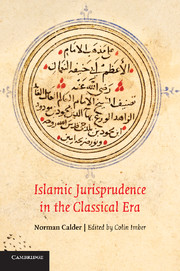Book contents
- Frontmatter
- Contents
- Editor's Preface
- Introduction
- 1 The Ḥanafī Law on Fornication
- 2 Nawawī and the Typologies of Fiqh Writing
- 3 Scholars, Muftis, Judges and Secular Power: The Need for Distinctions
- 4 The Social Function of Fatwas
- Afterword: Scholarly Priorities and Islamic Studies: The Reviews of Norman Calder (Robert Gleave)
- Principal Sources Used
- Index
2 - Nawawī and the Typologies of Fiqh Writing
Published online by Cambridge University Press: 04 May 2010
- Frontmatter
- Contents
- Editor's Preface
- Introduction
- 1 The Ḥanafī Law on Fornication
- 2 Nawawī and the Typologies of Fiqh Writing
- 3 Scholars, Muftis, Judges and Secular Power: The Need for Distinctions
- 4 The Social Function of Fatwas
- Afterword: Scholarly Priorities and Islamic Studies: The Reviews of Norman Calder (Robert Gleave)
- Principal Sources Used
- Index
Summary
Introduction
For the history of Shāfiʿī fiqh, the works of Yahyā b. Sharaf Muhyī al-Dīn al-Nawawī (631–76/1233–77) offer a unique point of convergence, for he analysed and summarised all that came before, and his work was the starting point for all that came after. He was a contemporary of Mawsilī, the most formal and classical of the Hanafī authors studied in the previous chapter. His academic career was spent in Damascus, during the early Mamluk period. He was trained at various madrasas, and became a teacher, associated in particular with the Dār al-Hadīth al-Ashrafiyya in Damascus. He died at the age of 44, having produced a large corpus of academic works of which the most important for the history of fiqh are the Majmūʿ (a commentary on the Muhadhdhab of Abū Ishāq Ibrāhīm b. ʿAlī al-Shīrāzī, d. 476/1083), the Rawda (a summary, with additions, of the Sharh al-Wajīz of Abūʿl-Qāsim ʿAbd al-Karīm b. Muhammad al-Rāfiʿī, d. 623/1227?), the Minhāj al-Tālibīn (a mukhtasar, based on an earlier mukhtasar by al-Rīfiʿī), and the commentary on the Sahīh of Muslim. Each of these will be discussed in this chapter, in Sections 1, 2, 3 and 4, respectively. His scholarship, conforming to the patterns of the time, had a broader range than just fiqh: Subkī said that he was skilled in a variety of sciences, including fiqh, hadith, biographies, language and tasawwuf.
- Type
- Chapter
- Information
- Islamic Jurisprudence in the Classical Era , pp. 74 - 115Publisher: Cambridge University PressPrint publication year: 2010
- 2
- Cited by

